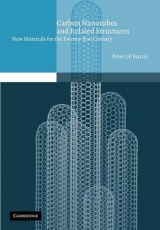
Carbon Nanotubes and Related Structures
Cambridge University Press (Verlag)
978-0-521-55446-6 (ISBN)
- Titel erscheint in neuer Auflage
- Artikel merken
This 1999 book covers all the most important areas of nanotube research, as well as discussing related structures such as carbon nanoparticles and 'inorganic fullerenes'. Carbon nanotubes are molecular-scale carbon fibres with structures related to those of the fullerenes. Since their discovery in 1991, they have captured the imagination of physicists, chemists and materials scientists alike. Physicists have been attracted to them because of their extraordinary electronic properties, chemists because of their potential as 'nano-test-tubes', and materials scientists because of their amazing stiffness, strength and resilience. On a more speculative level, nanotechnologists have considered possible nanotube-based gears and bearings. This was the first single-author book on carbon nanotubes. It will be of interest to chemists, physicists, materials scientists and engineers working on carbon materials and fullerenes from both an academic and industrial background.
Peter Harris was brought up in Gloucestershire and read chemistry at Birmingham University. He went on to study for a doctorate at Oxford University, where his project involved transmission electron microscopy of catalytic materials. Since that time his research has focused on the application of various forms of microscopy to problems in solid-state chemistry, and materials science. He has carried out post-doctoral work at both Cambridge and Oxford, and currently works in the Chemistry Department at Reading University, where he is responsible for electron microscopy. In addition to his work on carbon nanotubes and nanoparticles, he is involved in a wide range of projects for departments across the University. He has published over 40 scientific papers, and regularly reviews books for materials and microscopy journals. He lives in Twyford, outside Reading, with his wife and two daughters.
1. Introduction; 2. Synthesis; 3. Structure; 4. The physics of nanotubes; 5. Nano-capsules and nano-test-tubes; 6. The ultimate carbon fibre?; 7. Curved crystals, inorganic fullerenes and nanorods; 8. Carbon onions and spheroidal carbon; 9. Future directions; Index.
| Erscheint lt. Verlag | 25.11.1999 |
|---|---|
| Zusatzinfo | 1 Tables, unspecified; 86 Halftones, unspecified; 81 Line drawings, unspecified |
| Verlagsort | Cambridge |
| Sprache | englisch |
| Maße | 181 x 255 mm |
| Gewicht | 780 g |
| Themenwelt | Naturwissenschaften ► Chemie ► Anorganische Chemie |
| Naturwissenschaften ► Physik / Astronomie ► Festkörperphysik | |
| Technik ► Maschinenbau | |
| ISBN-10 | 0-521-55446-2 / 0521554462 |
| ISBN-13 | 978-0-521-55446-6 / 9780521554466 |
| Zustand | Neuware |
| Haben Sie eine Frage zum Produkt? |
aus dem Bereich



